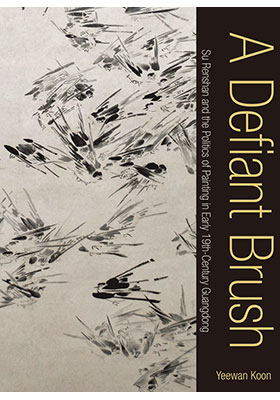A Defiant Brush
Su Renshan and the Politics of Painting in Early 19th-Century Guangdong
(蘇仁山與十九世紀初廣東的繪畫政治)
ISBN : 978-988-8139-61-3
May 2014
248 pages, 8″ x 11″, 94 color and 15 b&w illus.
For sale in Asia, Australia, and New Zealand only
- HK$350.00
As the Opium War unfold in Guangdong Province, the painter Su Renshan (1814–c.1850) exploded onto the art scene with a bold, paradigm-turning new voice. A Defiant Brush takes a fresh look at this underappreciated artist in the context of a nascent Chinese modernism.
In 1839, Guangzhou has shifted from a cosmopolitan trading center with a diverse art world into a place of violence. During the following decade, one voice of discontent and defiance rang out above all others: Si Renshan. His provocative, uncompromising, and sometimes ugly paintings berate Confucius for his hypocrisy. He turns his brush trace into graphic lines that mimic the printed page, and he depicts women as alternative exemplars of a moral intelligentsia. It is believed that his outspokenness prompted his father to place him in prison for filial impiety, where he probably painted his last work. During this turbulent period of incipient modernity, close readings of Su Renshan’s paintings within the rich contextual history of art in Guangdong Province reveal how the trauma of war prompted a re-evaluation of social and political values, and indeed the moral responsibility of a scholar-artist.
“Of all the periods in the Qing Dynasty, the one covering the first fifty years of the nineteenth century has been the least studied. In A Defiant Brush, Yeewan Koon plunges directly into this neglected period, and has had the admirable idea of framing these fifty years of Chinese history through the life of the painter Su Renshan (1814–c. 1850). Su defies all the basic categories of grandeur in Chinese art and life. He failed at the examinations, fell out with his family, held no office, played no dramatic part in the anti-foreign or anti-Manchu wars of the time, received no flattering colophons from his fellow artists in the Guangzhou hinterlands that he called home, held eccentric views on the place of women in Qing society, and through his constantly changing styles defied the aesthetic norms of his time. Koon brings order and focus to the elusive yet engrossing man, and through her broad selection of Su’s surviving paintings and documentary fragments she substantially deepens our understanding of late Qing history and society.” —Jonathan Spence, author of The Search for Modern China
“This book is a major contribution to our understanding of the painter Su Renshan in specific and nineteenth-century art in Guangdong in general. It provides lucid and thought-provoking discussions on the art world and local society that strived to cope with the tremendous political and socio-economic changes of late Qing China. Through close readings of the works by Su Renshan and other Guangdong painters, Yeewan Koon demonstrates the intricate negotiation of different levels of identities, which were expressed through and shaped by the defiant brushes of these painters.” —Cheng-hua Wang, Academia Sincia, Taiwan

